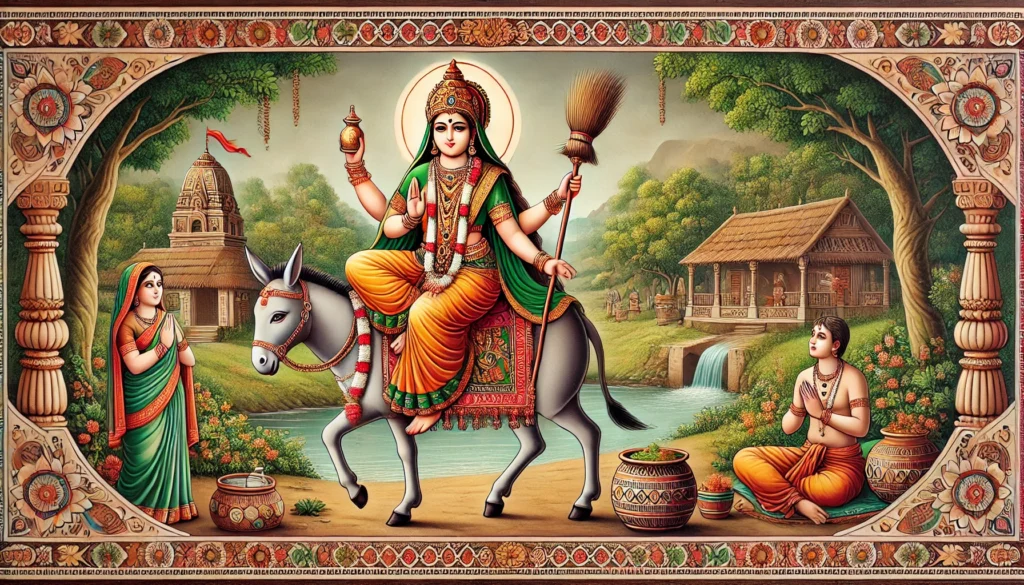Discover the story of Shitala Devi, the goddess of healing smallpox, and her significance in Hindu mythology. Learn about her role, symbolism, rituals, and modern relevance in promoting health and well-being.
In the vast and intricate tapestry of Hindu mythology, many deities symbolize natural phenomena, human virtues, and societal needs. Among these revered figures, Shitala Devi, the goddess of healing and disease prevention, occupies a unique place. Particularly worshipped for her role in protecting communities from smallpox, Shitala Devi represents compassion, care, and the eternal fight against suffering. Her presence is a testament to the ancient understanding of health and the reverence for divine intervention in medical crises.

This article delves into the origins of Shitala Devi, her significance in mythology and culture, her symbolic role in the battle against smallpox, and her lessons for modern times.
Origins and Mythology of Shitala Devi
Shitala Devi’s name is derived from the Sanskrit word “shitala,” meaning “cooling” or “soothing.” True to her name, she is often depicted as a cooling presence, believed to alleviate fever and other symptoms of smallpox and related ailments. Her origins trace back to ancient Indian texts and folklore, where she is described as a protector against epidemics.
In the Devi Mahatmya and other Hindu scriptures, Shitala Devi is portrayed as a compassionate goddess riding a donkey, holding a pot of healing water in one hand and a broom in the other. The pot symbolizes her ability to soothe and heal, while the broom is believed to cleanse the environment of diseases. She is often accompanied by Jvara Asura, the fever demon, highlighting her ability to control and pacify illnesses.
For further details on Shitala Devi’s iconography and her role in Indian mythology, visit this resource on Hindu deities.
The Role of Shitala Devi in Healing Smallpox
Historically, Shitala Devi became widely worshipped during times when smallpox was a deadly and recurring epidemic. In a world without vaccines or antibiotics, her devotees sought her blessings for relief from the disease’s devastating effects. Temples dedicated to Shitala Devi became centers of hope, prayer, and traditional healing practices.
Traditional Practices and Rituals
- Sacred Offerings: Devotees would offer cool foods like rice, yogurt, and sugar, symbolic of her cooling nature. These offerings were believed to appease the goddess and bring relief to those suffering from high fevers and rashes.
- Fasting and Prayers: Special fasts were observed on certain days, accompanied by prayers seeking protection against smallpox and other contagious diseases.
- Environmental Cleansing: The broom in Shitala Devi’s imagery symbolizes the ancient practice of cleaning homes and surroundings to prevent the spread of disease. This aligns with modern understandings of hygiene and its role in disease prevention.
Learn more about the cultural significance of rituals in health at UNESCO’s cultural heritage portal.
Symbolism of Shitala Devi
Shitala Devi’s iconography and myths are rich with symbolic meaning, connecting her role as a healer to broader concepts of health and harmony:
- Healing and Renewal
Shitala Devi’s cooling nature symbolizes the relief and renewal that follow recovery from illness. Her presence reassures devotees of life’s regenerative power. - Balance and Harmony
Her role as a disease goddess emphasizes the importance of balance—between cleanliness and chaos, health and illness. Shitala Devi reminds us that disease often stems from imbalances, whether environmental or personal. - Community and Compassion
Worshipping Shitala Devi often involved communal prayers and rituals, highlighting the collective responsibility in combating diseases.
Modern Relevance of Shitala Devi
Although smallpox has been eradicated globally through vaccination efforts, Shitala Devi’s significance persists, symbolizing the ongoing battle against diseases and the value of preventive healthcare. Her story resonates with modern efforts to combat pandemics, such as COVID-19, and underscores timeless lessons:
Lessons from Shitala Devi for Today’s World
- Hygiene and Prevention
The emphasis on cleanliness in Shitala Devi’s worship mirrors the importance of hygiene in preventing disease. Practices such as washing hands, maintaining clean surroundings, and using disinfectants are modern extensions of her teachings. - Vaccination and Community Health
Just as communities once gathered to seek Shitala Devi’s blessings, today’s collective efforts focus on immunization and public health initiatives. Vaccines, like the smallpox vaccine, have transformed healthcare, saving millions of lives. - Compassion in Healthcare
Shitala Devi’s compassionate nature reminds us that healing is not just physical but also emotional. Modern healthcare providers can draw inspiration from her example, ensuring empathy and care in their approach. - Environmental Awareness
The goddess’s connection to cleanliness and balance extends to environmental health. Protecting natural resources and reducing pollution align with the principles she embodies.
For practical tips on environmental health, check out this article by the World Health Organization (WHO).
Festivals Dedicated to Shitala Devi
Shitala Devi is celebrated in various parts of India, particularly in states like Uttar Pradesh, Rajasthan, Gujarat, and West Bengal. Festivals dedicated to her are marked by vibrant rituals and community gatherings:
- Shitala Ashtami: Observed during the Hindu month of Chaitra (March-April), this festival involves fasting, offering cool foods, and praying for protection against diseases.
- Regional Variations: In West Bengal, Shitala Devi is worshipped with great fervor, with devotees offering cool water and traditional sweets.
Learn more about Hindu festivals and their cultural significance.
Shitala Devi in Art and Literature
The depiction of Shitala Devi in Indian art reflects her dual role as a healer and protector. Paintings, sculptures, and folk art often portray her serene yet powerful demeanor, surrounded by symbols of healing and renewal.
- Sculptures: Temples dedicated to Shitala Devi feature intricate carvings of her holding her characteristic pot and broom.
- Folk Art: In rural India, colorful folk paintings depict her riding her donkey, emphasizing her connection to common people and their everyday struggles.
To explore more about Hindu deities and their cultural significance, visit Hindutva Online for comprehensive insights into ancient traditions and their relevance today.
Shitala Devi is much more than a goddess of healing; she is a timeless symbol of compassion, community, and the human spirit’s resilience against adversity. Her teachings about balance, hygiene, and collective care remain relevant in today’s world, offering lessons not just for physical health but for holistic well-being.
As we navigate modern challenges, from pandemics to environmental crises, Shitala Devi’s story reminds us of the enduring power of ancient wisdom. By embracing her principles, we can create a healthier, more harmonious world.
Author:
Sunita Reddy – Mythologist & Storyteller

